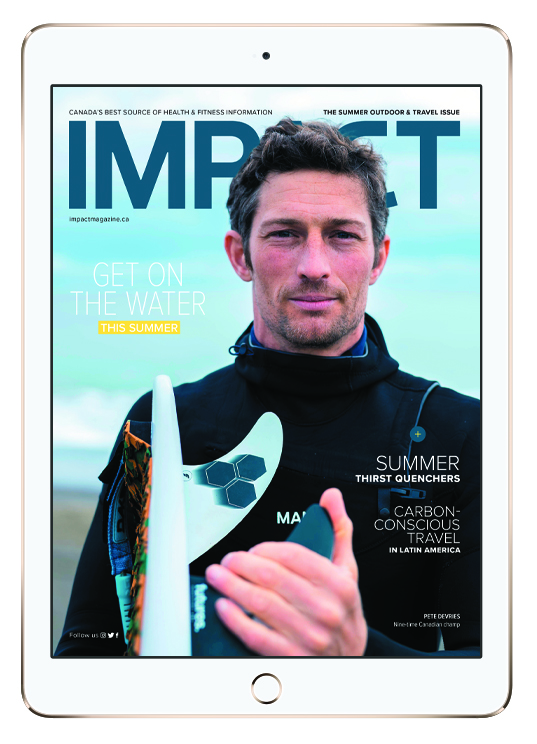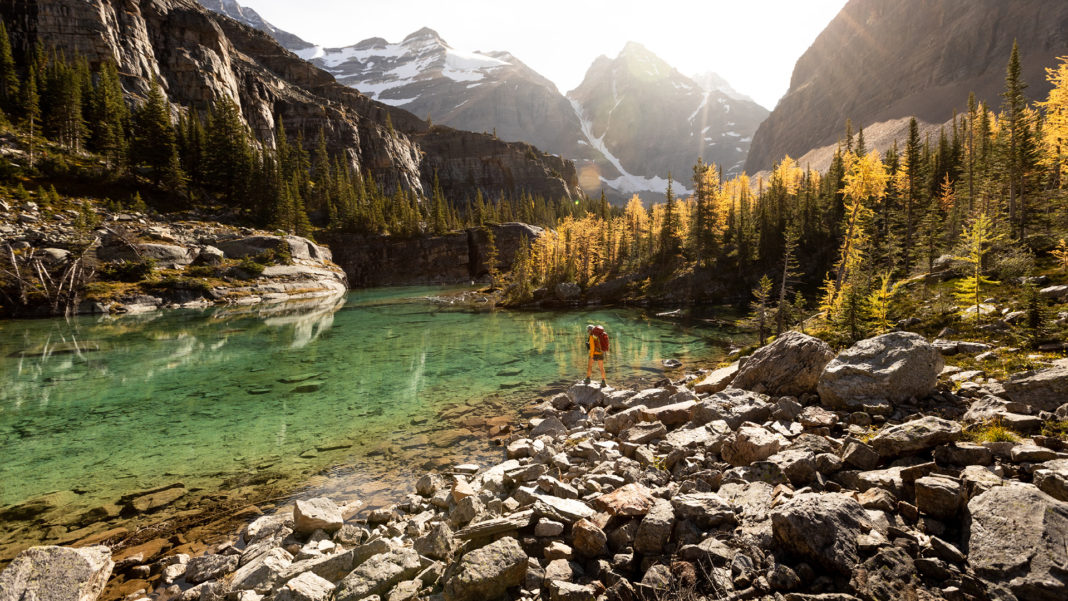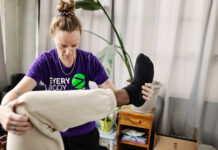Hiking is a popular summer activity in the Canadian Rockies, and it’s a fabulous way to explore our beautiful backcountry, get some fresh mountain air and spend quality time with friends and family. As a physiotherapist in Canmore, AB, I see plenty of hikers limp through our clinic door looking for treatment and advice.
How can we prevent hiking injuries? And what are some common hiking injuries? A bit of knowledge, planning and effort can go a long way to optimize your time in the mountains.
GEAR UP
It’s worth investing in a well-fitting pair of hiking boots with good support, cushioning and traction. High-quality footwear offers a good base to start the day off right and minimize unnecessary aches and pains. Take along some light hiking poles, as they help with balance and reducing the load on your joints. Knee and ankle braces can be very effective for extra support and reducing pain
and you may consider custom orthotics for optimal comfort. Control your body temperature with base layers and a breathable waterproof fabric like Gore-Tex. Don’t forget a simple first aid kit with kinesiology tape and blister pads.
PRE-SEASON TRAINING
Do you ever wonder why you can ski all winter, but your quads ache after your first summer hike? Sports are specific and put different demands on your body.
Squats, lunges and stair workouts started several weeks prior to your first day out in the mountains can help immensely to prevent overuse problems. Consult with a physiotherapist to target any potential problem areas and start a hiking-specific fitness program. It will make your mountain adventures that much more enjoyable.
EASE INTO IT
Like any seasonal activity, it’s best to ease into your summer backcountry adventures and slowly progress the length and difficulty of your hikes. You wouldn’t run an ultra-marathon untrained, so why choose the most challenging mountain on your first day out? Gradual progression is key to injury prevention.
KNOW YOUR ROUTE
Do your homework before you go to prevent unexpected long days, unnecessary bushwhacking or scrambling on difficult terrain. Check out the trail, weather and avalanche reports, and be prepared for the unexpected.
FUEL UP
Many injuries occur when hikers “bonk “or “hit the wall”. Fatigue can increase your chances of stumbles, falls and muscle cramps. Ensure you have plenty of fluids and high-calory snacks to keep your hydration and energy high.
After a big day out, allow your body to recharge, and let your overused muscles and tendons recover before your next day out.
REST AND RECOVER
After a big day out, allow your body to recharge, and let your overused muscles and tendons recover before your next day out. Mobility work, yoga, ice baths and foam rolling will help. Drink plenty of fluids and get your sleep.
Unfortunately, even the most prepared hikers can get injured, and accidents happen. Here are a few common injuries, symptoms and recommended treatments.
SPRAINS are caused by an injury to a Iigament, and range from partial to complete tears. Ankle or knee sprains usually occur with a trauma such as a twisting injury, slipping on loose rock, or tripping on a root. Acute signs and symptoms can include pain, swelling, bruising, and difficulty walking properly. If you are unable to put weight on it, get an X-ray to rule out a fracture. Most ligament injuries heal with the proper medical and physiotherapy management and time. Complete tears may require surgery.
STRAINS involve damage to a contractile tissue, such as a tendon or muscle. Strains can occur from repetitive overuse such as a multi-day hike with a heavy pack. An unexpected slip or fall can cause a complete muscle tear or tendon rupture. Most strains can heal well with the appropriate rest, treatment and progressive loading program. A complete tear, such as a patellar tendon or achilles tendon rupture, requires consultation with a sport medicine physician and/or an orthopedic surgeon for diagnosis and acute management. Tendon injuries can also be diagnosed as a tendonitis (acute inflammation) or tendonosis (chronic deterioration of the collagen tissue).
HEEL PAIN is a very common complaint amongst hikers. Improper footwear, flat feet and gait abnormalities are potential causes of heel pain. The plantar fascia, a connective tissue that spans the base of your foot, is often the culprit. Repeated and prolonged pressure on the heel can cause plantar fasciitis- micro tearing and inflammation of the fascia. It is often described as a burning sensation, and can be quite debilitating. Don’t ignore heel pain, as it can lead to chronic inflamed nerves and painful bone spurs. Proper footwear, heel cushioning, taping and orthotics are helpful.
KNEE PAIN that worsens with going downhill is often due to repetitive loading of the patella (kneecap) and/or friction of the iliotibial band. Factors that may contribute to this can be poor lower body alignment and biomechanics, shortened or tight muscles, or weak quadriceps, hips and core muscles. Osteoarthritis or wear and tear in your knees can cause knee pain, but this should not prevent you from getting out. Keep your hikes moderate, use hiking poles, and taping or knee braces can be beneficial.
If you do have an injury, take a rest from activities that aggravate it. Crutches and/or a brace may be helpful initially, and get started on elevation and contrast baths. Consult an experienced physiotherapist who deals with sports injuries immediately. Your physio will do a thorough bio-mechanical assessment to diagnose your injury, and create a rehab plan for you. Physiotherapy treatment may consist of modalities such as acupuncture, manual therapy or IMS/dry needling to reduce pain and swelling, and improve mobility. Specific exercises will also be recommended to improve strength, balance and proprioception.
As a physio in a mountain town, I love to see people being active and reaching their outdoor adventure goals. Do what you can to prevent injuries, and see you out there on the trails!
Photography by Katie Goldie Photography
You May Also Like
Diagnosing Summertime Foot Injuries
Top 5 Hikes Near Calgary
Top 5 Hikes Near Vancouver

Read This Story in Our 2022 Summer Outdoor & Travel Digital Edition
Cold Water King, Core-Centric Fitness, Prepare for Hiking Season, Mountain Bike Fundamentals, The Simple Ways Movement Gives Us ‘Hope’, recipes and much more!

















